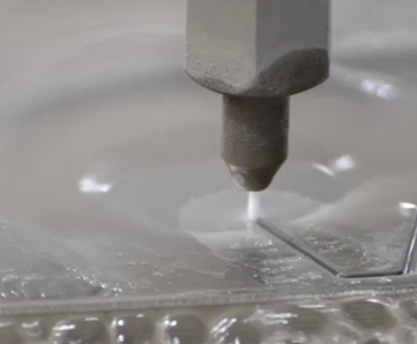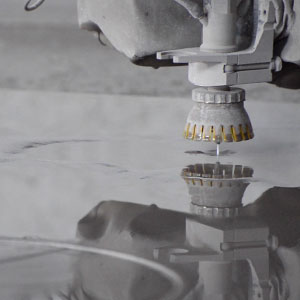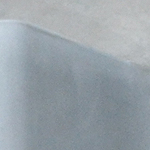
to meet the specific needs and tolerances
of your custom stainless steel parts.

In the 1930s mining technology evolved to employ narrow jets of water as an industrial cutting device. Water jet technology evolved in the post-war era as researchers around the world searched for new methods of efficient cutting systems when Union Carbide explored using a pulsing water jet at up to 100,000 psi to cut metals, stone and other materials.
In the early 1970s, seal technology advancements and plastics innovations led to the development of the first reliable high-pressure pump that brought water jet cutting into the manufacturing world.
Adding Abrasives
While cutting with water is possible for soft materials, the addition of an abrasive turned the water jet into a modern machining tool for all materials. In 1935, abrasives were added to the water stream resulting in modern abrasive water jet cutting technology. Durable, ceramic tungsten carbide composite mixing tubes deliver the abrasive and withstand the power of high-pressures increasing the operational life of the commercial cutting machine.
Today, SPP can control the computerized cutter with great precision by precisely positioning the water jet nozzle while accurately specifying the speed at every point along the path. The largest water jet manufacturer, Flow International (a spin-off of Flow Industries), recognized the benefits of that system and licensed the OMAX software, with the result that the vast majority of water jet cutting machines worldwide are simple to use, fast and accurate.
Operation
The cutter is commonly connected to a high-pressure water pump where the water is then ejected from the nozzle, cutting through the material by spraying it with the jet of high-speed water. Additives in the form of suspended grit or other abrasives, such as garnet and aluminium oxide, can assist in this process.
Benefits

An important benefit of the water jet is the ability to cut material without interfering with its inherent structure, as there is no "heat-affected zone." Minimizing the effects of heat allows metals to be cut without harming or changing intrinsic properties.
Water jet cutting is typically the better choice for flat parts with intricate profile details and tight tolerances. Our systems are equipped with 100HP pumps with water jets delivering 100,000 psi so there is no practical limit on material thickness. With specialized software and 3-D machining heads, SPP can produce complex stainless steel shapes.
Water jet cutting is capable of cutting materials over eighteen inches (45 cm) thick.
| Process | Max. Gauge | Cut Quality |
Cut Tolerance |
Delivery Turn-around |
Heat Affected Zone |
| Machine Cut | Any | ||||
| Nitrogen Plasma | 3" | ||||
| Argon Plasma | 6 1/2" | ||||
| HD Plasma | 6" | ||||
| Water Jet | Any | ||||
| Bevel Cut | Any |
Depending on the finish dimensions, type, gauge and intended use, there are usually a number of ways to produce any given part or shape. Each method has its advantages and our experienced sales team is ready to help you select the cutting option with the best quality, delivery and overall value for your application.
Unsure which is the best choice for your stainless plate products?
Let SPP help you choose the best method for your parts. Contact us today!